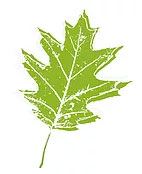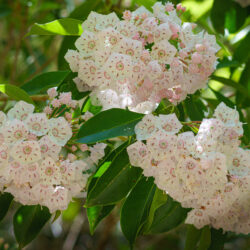Etymology
Genus name, Kalmia, honors Pehr Kalm (1715-1779), Finnish pupil of Linnaeus, who was sent by the Swedish government in 1748 to report on the natural resources of North America. Latifolia means “wide leaf,” a characteristic that differentiates this from other species of Kalmia.
Native Habitat
Mountain laurel is native to Eastern North America where it is found in a variety of habitats including open rocky or sandy woods, cool meadows, balds, mountain slopes, acidic forests and woodland margins. It is considered a rare plant in Maine and has been documented in only 23 towns.
Garden Uses
A close relative of rhododendrons and azaleas, mountain laurel is an excellent choice for shady gardens. It shines for its evergreen foliage, showy flower clusters, and multi-stemmed growth habit. Plant mountain laurel as an understory shrub, along a woodland edge, or as an accent in shady gardens. Like other members of the Ericaceae family, mountain laurel thrives in well-drained, moist, acidic soil. It can be difficult to find the straight species in the nursery trade, but it is worth the search at flowering time.
Overview
Kalmia latifolia is a multi-stemmed, broadleaf evergreen shrub or small tree with excellent spring flowers and quality year-round foliage. It typically grows as a dense rounded shrub to 5-15’ tall, opening up and developing gnarly branches with age. Best grown in cool, moist, rich, acidic, humusy, well-drained soils in part shade. Mulch to retain moisture and keep root zones cool. Plants do not grow well in heavy clay soils. Plants tolerate a wide range of light conditions (full sun to full shade), but are best grown in part shade (morning sun with early to mid-afternoon shade). In deep shade it won't produce as many flowers and can become spindly. Too-bright sun can cause scorching of the leaves. Pinch off spent flowers so the plant can put its energy into next year’s blooms instead of reproduction. Deadheading also helps to prevent legginess. Prune lightly after bloom to promote bushy growth.
Spread
Above ground spread typically ranges from 5 to 15 feet.
Leaves and Stems
Elliptic, alternate, leathery, glossy evergreen leaves (up to 5” long) are dark green above and yellow green beneath and reminiscent to the leaves of rhododendrons. The bark of adult plants is ridged and peels off easily.
Flowers
Showy cup-shaped flowers appear in terminal clusters (corymbs up to 6” across), typically covering the shrub in late May-June for several weeks with an often exceptional bloom. Each individual flower (up to 1” across) is cup-shaped with five sides and ranges in color from white to pale pink and is distinctively tattooed with symmetrical darker pink dots or streaks. Flower stamens have a springlike mechanism which spreads pollen when tripped by a bee. Cultivars can have all shades of pink to deep rose and maroon flowers with darker markings.
Fruit/Seed
If not deadheaded, flowers give way to non-showy brown fruits (3/16” dehiscent capsules) that persist into winter.
Wildlife Associates
Larval host plant for the Laurel sphinx moth. Susceptible to deer, borers, scale, white fly, and lace bugs. It is also susceptible to leaf spots and blights.
Propagation
Can be propagated by seed and by cuttings. Collect seeds in autumn for winter sowing. Seeds need to be stratified in 40 degrees F in sand for 3 months. Preferred temperature for germination is 74 degrees F. It takes about 6 weeks for seeds to germinate. Light increases germination. To propagate by cuttings: take a softwood stem tip cutting from a 2-3 year old plant in autumn. Use a rooting hormone and mist the cutting intermittently. Soil temperature best for rooting is 73-75 degrees F.
Ethnobotanical Uses
All parts of this plant are toxic if ingested. The wood has been used for tool handles and turnery, and the burls (hard knotlike growths) for briar tobacco pipes.
Garden Location
Patio Garden (see garden map)
Anecdotal Information
In the NGBH garden, mountain laurel is located in a shady woodland edge garden. It is slow growing and susceptible to deer damage.
Sources
International Plant Propagator’s Society
Lady Bird Johnson Wildflower Center
Plant Profile by Rachel Emus





